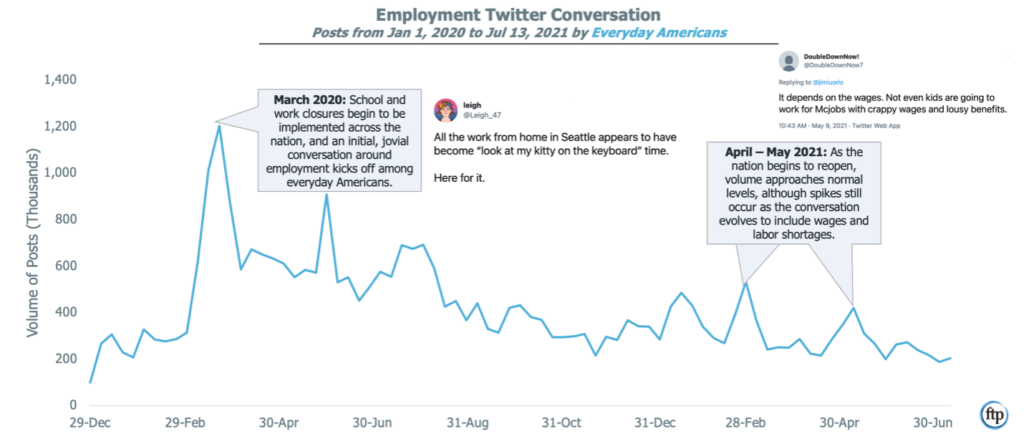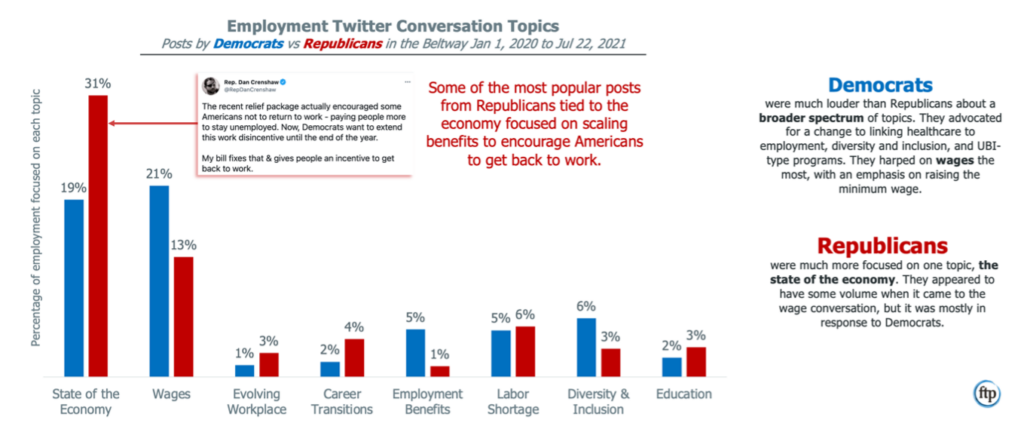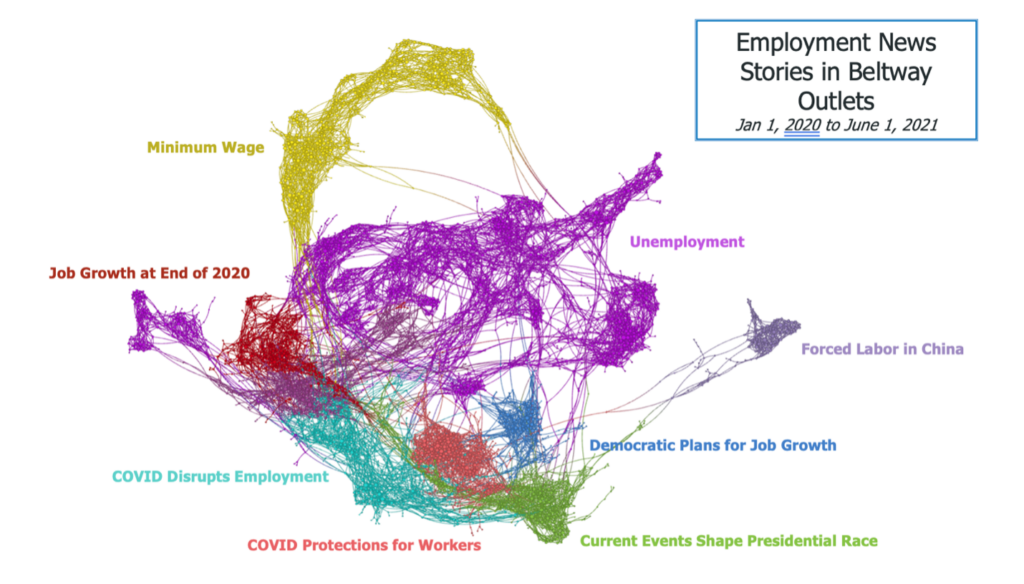As Americans go back to work after more than a year of layoffs and remote work, our team examined the conversation on Twitter around employment and its connection to traditional media coverage of the topic. We analyzed over 1.6 million Twitter posts and 16,000 news stories since January 2020. Through our analysis, we discovered changing narratives, important areas of focus, and critical moments in the conversation and coverage.
To download the full report, click here.
Overview

March 2020 marked the peak of employment conversation on Twitter, which remained high but changed in tone throughout the pandemic.
We saw a significant increase in the volume of conversation about employment following nationwide closures at the start of the pandemic. Volume stayed above pre-pandemic levels through 2020 and into 2021, however the tone of conversation on social media shifted. When the pandemic began, conversation among everyday Americans was playful and lighthearted. Working from home was new and stay-at-home orders were believed to be temporary. As the shutdown continued, posts became increasingly serious.
Peaks in traditional media coverage of employment were caused by major events, with unemployment at the heart of coverage.
Like conversation on social media, coverage of employment increased significantly when the pandemic hit the U.S.. Traditional media covered the evolving situation, as non-essential businesses shut down and Americans shifted to remote work. Unemployment also became a major focus of traditional media outlets, with news stories educating readers about relevant topics like the stimulus bill and its unemployment benefits.
Volume of coverage declined after the summer but spiked again after another major event: President Biden taking office. Minimum wage became a major focus due to debates in Congress over the American Rescue Plan. At the same time, unemployment continued to be at the center of coverage. However, focus notably shifted from providing unemployment benefits to ending them.
The COVID Era:
News stories about unemployment dominated the traditional media landscape, with consistently high engagement from the public.

Traditional media created a new interest in the changing nature of the workplace on social media.
The pandemic also sparked an interest in the changing nature of the workplace. Americans who were still employed wondered how the pandemic would impact their jobs. Would remote work become the new normal? Would the workday shorten? We found that the topic was first covered by traditional media outlets soon after stay-at-home orders began in early March. This coverage set up the conversation for everyday Americans, which began on social media a week later. Following these peaks in March 2020, traditional media coverage of the topic fluctuated, while the conversation on social media was more consistent. A year later, adaptive work environments are now becoming the norm. Industry giants like Amazon and Kickstarter have announced remote work flexibilities and four-day work week experiments, while nations like Spain and Iceland advocate for changes to the workplace.

On social media, Beltway Insiders used the pandemic as an opportunity to push policy.
For Beltway Insiders, the pandemic marked a unique opportunity to push policy agendas. Compared to everyday Americans, the employment conversation among Beltway Insiders fluctuated regularly. During peaks in volume, their posts focused on what the government should or should not do in response to the changing state of employment. Posts from Democrats drew the highest engagement, often focusing on workers’ rights, income disparities, and employment benefits.
The Post-COVID Era:
Amidst fears of a labor shortage, the conversation around unemployment benefits has become negative.
We found that a second perspective on unemployment emerged in 2021, with unemployment benefits now seen as a threat to recovery. As the country’s priority has shifted toward returning to work, a Hill-HarrisX poll found that voters now blame unemployment benefits for keeping unemployed Americans from searching for jobs. 71% of voters think unemployment benefits are at least part of the reason unemployed Americans are not returning to work. That number rises among Republicans; 84% of whom say unemployment benefits are a problem.

In actuality, reasons like lack of available jobs or concerns about COVID have played a larger role in people’s decision to not return to work. A survey by the U.S. Chamber of Commerce found only 16% of unemployed Americans have enough money from unemployment benefits that they do not want to look for work.
Nonetheless, this misconception has been a large part of the employment conversation, especially as concerns of a labor shortage have grown. Social media has indicated there is a different reason why companies are failing to hire people: wages and working conditions. Rather than blame unemployment benefits, everyday Americans are calling for companies to step up.

Traditional media narratives about employment are shifting focus.
We found that a distinct and separate conversation about minimum wage emerged in 2021 after Biden took office. This topic first moved toward the forefront of coverage when Congress negotiated the American Rescue Plan, leading to a partisan debate over raising minimum wage to $15 which Beltway media outlets followed intensely. At the same time, there was also narrative around minimum wage emerging outside of Congress, as massive companies like Walmart and Costco independently increased their wages to $15 per hour or more. With Congress ultimately removing minimum wage from the stimulus plan, this topic is likely to be an increasing area of interest for traditional media outlets, especially as unemployment becomes less relevant.
After initially coming together to fight unemployment during the pandemic, we also found that the left and right have returned to their pre-pandemic ways, focusing on the issues most important to their audiences. While unemployment has continued to be an area of interest for the left and right, coverage from right leaning outlets like Breitbart and The Washington Examiner has shifted toward ending unemployment benefits and getting Americans back to work. In contrast, coverage from left leaning outlets like Vox and Salon has increasingly focused on minimum wage and getting protections and benefits for workers. These more partisan news stories draw high engagement from readers, indicating that the divergence between coverage from the left and right will likely continue post-pandemic.
Contradicting opinions have emerged from conversations about UBI and other regular payments from the government.
The pandemic caused many Americans to require assistance from the government, allowing Beltway Insiders to reintroduce conversations regarding UBI, either mentioning it by name or mentioning something like relief checks that appeared to be a very similar concept. We found that Beltway Insiders – especially Democrats — were far more active in the conversation about checks to voters and other concepts like UBI, but rarely discussed UBI by name. This difference was even larger among Republicans.
Interestingly, we saw evidence that this difference also appears in public opinion. A Monmouth poll found 81% of voters supported a stimulus check, and Data for Progress found 56% support extending the Child Tax Credit permanently. However, despite majority support for these regular government payments, only 45% of Americans support UBI according to Pew Research.
The topic of career transitions has gained momentum on social media as the world enters a post-pandemic workplace.
With many Americans experiencing stalls in their careers during the pandemic due to fewer promotions, stagnant salaries, etc., we found that a distinct conversation regarding career transitions developed on social media. For Americans who were dissatisfied with their careers, disruptions caused by COVID were an opportunity to make radical career moves. As a result, the conversation around career transitions spiked among everyday Americans during the start of the pandemic, when work suddenly changed for millions of people. However, since 2021, the conversation has gained momentum once more, as the workplace shifts toward a post-pandemic era.
FTP’s Joshua Britt and Hannah Ritz also contributed to this report.
